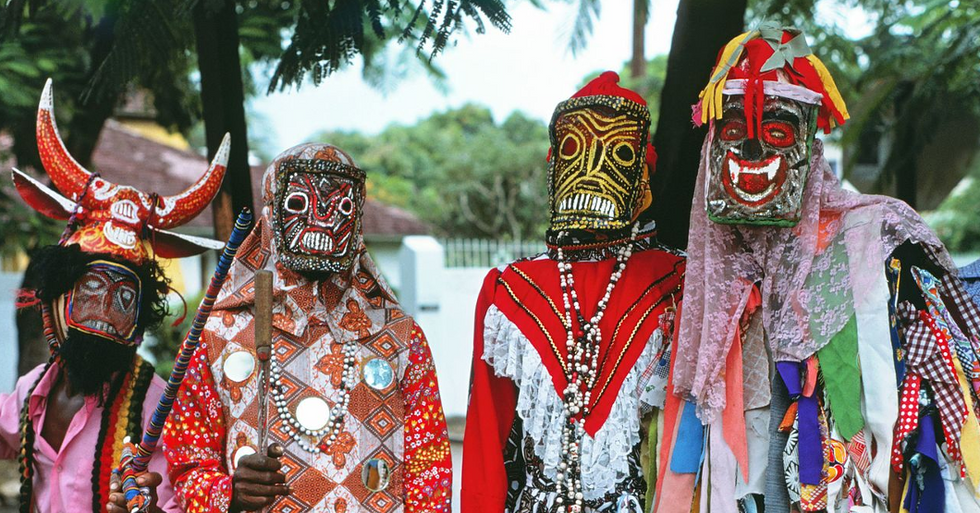It begins in the weeks approaching Christmas.
You can hear them coming from a mile away. They beat their primitive, handmade drums and blow trumpets made from the horns of bulls. They burst into sight and consciousness, a prancing, chanting, procession of fierce masked men and women. They are the living caricatures of mystical beasts and slave owners, some of their significance long lost in the memory of our African ancestry. They are the “jonkanoo.”
Among children, there's always one of two responses to the arrival of the jonkanoo. Some race to the streets or the houses they visit to watch the spectacle. Some quiver in fear and flee. As a child I often succumbed to the urge to run away, heart hammering away as my desire to watch the parade warred with my sense of self-preservation.
I'll never forget the time a jonkanoo dancer wearing a bull's mask and horns chased me into my house. I must have been six or seven years old at the time. It was terrifying but hilarious.
Junkanoo History
Jamaican Junkanoo (John Canoe) is a form of traditional dance that blends dance, mime, and symbolism communicating the ideology and experience of the slave with roots in West African religion. The mask is of great importance in African religions. Jamaica's slaves were individuals who had been ripped away from various tribes. They spoke different languages and practiced different rituals. They believed in different gods. They were thrown together by circumstance and were able to form their own unique culture and traditions, which included the junkanoo parade.
Jamaicans.com columnist, Marcia "Ackeegiel" Davidson, wrote:
"This African-rooted, African-inspired body of folk cultures, was the African-Jamaicans’ response to uprooting and alienation during the century after emancipation, when society felt the full force of colonialism. There was no other link, no other indigenous form of self-expression, no other source from which to nourish the sense of African identity" (Davidson).
Jamaican vs. Bahamian Junkanoo
Although the customs are similar and perhaps have the same African roots, there are some marked differences between Jamaican and Bahamian Junkanoo. For instance, in the Bahamas, the parade is usually on Boxing Day (Dec 26) and New Year’s Day (Jan 1) whereas the Jamaican Junkanoo pop up randomly during the Christmas Season. The Bahamian Junkanoo parades are much larger in scale and the revelers much more flamboyant than the Jamaican Junkanoo. The feeling of the Bahamian junkanoo is more like a modern Caribbean carnival while the Jamaican version of junkanoo seems to be more deeply rooted in tradition.
Legacy
Decades later and an ocean away, I remember the junkanoo with a certain sense of nostalgia and fondness. I miss those sights and sounds as much as I miss the taste of sorrel and Jamaican sweet potato pie. I think that as a child, I truly believed on some level that in masquerading as the junkanoo, these people had truly become something other than human. Beyond the fear I felt, I could hear something else. It was perhaps, the faint echo of a heartbreaking cant for lost memories.
All descendants of slaves and misplaced societies carry this song in our hearts. To this day, I remain convinced that threaded into the cacophony of horns and drums, and movements of the junkanoo dancers is, perhaps, the forgotten truths of our people; past, present and future.Resources:
Davidson, Marcia. “ Culture John Canoe or Jonkonnu Parade.” Jamaicans.com, 15 Mar. 2015, jamaicans.com/johncanoe/.



















